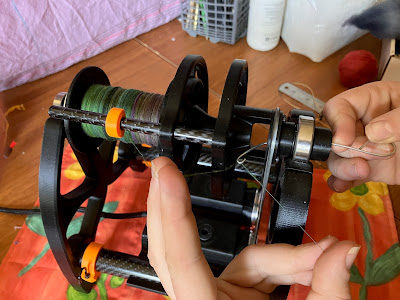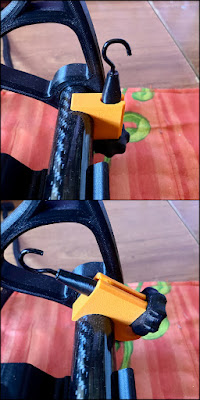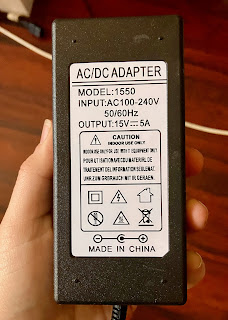I confess, this is a departure from my usual "let's do things with the least amount of money we can get away with" style. In my defence, I strive to be frugal rather than cheap. I don't mind spending the money to get a good quality, durable product, if it's something I know will get a lot of use. An e-spinner definitely fits that category for me, for several reasons.
One, I fall well on the frog hair end of the spinning spectrum, something most traditional wheels just aren't designed to accommodate. I actually found it faster (and easier on my legs) to use a spindle for the kinds of fine, high-twist yarns I prefer to spin. But, there are limits to how fine I can comfortably go on a spindle - anything past about 50 WPI and I have to concentrate just on the spinning. Not good when you typically use a spindle on the go.
Two, I have a lingering knee injury that doesn't like the treadle action of most spinning wheels (something I find hilariously frustrating given I ride a cargo bike anywhere I can't take the train).
Three, I spin mostly to weave. Much as I love spinning, I like it to end eventually so I can move onto the weaving part of the equation.
After three straight months of research, the Daedalus Falcon came out as the hands-down winner for my goals of speed, fine yarn, and product durability.
Why Daedalus?
Daedalus manufacture high-end e-spinners and spinning accessories. All their products are designed to need little to no maintenance, and to last 20+ years - they're seriously well put together.
They make five different e-spinners to suit just about any spinning preference, from super bulky art yarn to ultra fine frog hair. The Falcon is specifically designed for production spinning of fine yarns - it can reach speeds of 4,200 RPM, over twice what I could get from my Ashford Traditional wheel.
Ordering
I'll be honest, I spent a long time thinking about which model, and whether to order a Daedalus at all. These beauties are high-performance machines built to last. But, that means they come with the price tag of a high-performance machine. Plus currency exchange. Plus postage. (Yikes.) In all, I spent just under AU$2,000 on my Falcon set-up (I ordered three extra bobbins at US$90 and some yarn control cards for US$24).
At the time I ordered (November 2022), there was an estimated wait time of 12 months or more. Luckily for me, if not my bank account, Daedalus expanded their production capacity over the 2022 Christmas break. I reached the front of the Falcon queue in June 2023 (seven months from sign-up). At the time of writing (September 2023) there is no queue for the Falcon, and the Daedalus team are working to banish their waitlists completely.
The package
My Falcon came party disassembled, cradled in bubble wrap. (I wasn't thinking about writing a review when I ordered it, so I didn't take pictures.) The flyer assembly was individually wrapped for transport, as were the speed controller, inverter, cables, and welcome pack/spares bag.
The inverter is a standard laptop style pack. It comes with a US-ended jug
plug, but that's easy to change out for whatever your local plug end is. I
dove into my box of spare cables and leads and had a compatible jug plug in
less than two minutes. If you don't have a box of old computer cords lying
around, what century did you time travel from plan ahead and buy
a new one.
Importantly, the inverter outputs 15 volts! Make absolutely sure that you've got the right one when you go to spin! Most laptops nowadays run on 20 volts - you don't want to damage the motor by running it faster than it's designed for.
The extension cable for the speed controller, and the power end on the motor itself, is some non-standard end that I've never seen before. (It's probably very common among people who know things about electronics; I'm not one of them.) It's similar to USB-A connectors in that the ends are directional; if you don't get them the right way up, they won't connect. The cord itself has a protective, braided outer and feels very sturdy.
The Instructions
The guidebook (also available as a PDF on their website) is beautifully designed, and clearly written. The parts diagrams are clearly photographed and labelled. I've found the instructions easy to follow, even with a scattered brain.
It includes:
- getting started
- fine tuning the tension
- how to use the speed controller
- a page of "handy tips"
- how to change the bobbin
- an RPM speed table
- changing settings in the speed controller menu
- maintenance
- flat packing for travel
- the Daedalus battery (purchased separately)
- Daedalus' social media and contact details
The first page has a QR code that takes you directly to the Daedalus YouTube channel, where you can find videos on how to assemble and disassemble each model. My one quibble here is that the QR code takes you to the channel as a whole, rather than to the specific playlist for the model you bought. The videos themselves are short, to the point, and well shot with clear lighting and narration.
Also, the manual states that the speed controller has been limited to 50% max speed in the settings - mine wasn't. I've seen other folks on social media also say their controller wasn't speed limited for this model, so it's something to watch out for.
About that battery
Daedalus offer a battery bank that's designed to work with all their e-spinners (yay!). Unfortunately, due to issues with postage, they don't mail them outside the continental US (boo!).
While their website does say that they'll help you find a compatible battery that you can purchase in your country, this is complicated by the part where all their stuff runs on 15 volts. In Australia at least, 15v battery banks with a standard laptop cable input simply don't exist. I spent six weeks trying to find somewhere to buy a battery - I eventually gave up due to my brain frying any time I tried to look at listings.
While I'd like the option of a battery eventually (it would be much easier to set up in the back yard that way), for now I've made peace with needing to lug extension cords anywhere I want to spin.
Spinning Experience
So far I've only spun commercially prepared wools, so this won't be a thorough review of the Falcon's performance over a variety of fibres and preps. (I'll attempt that later, when I get the chance. And finer wool cards.)
Noise
It's quiet. Really quiet. At least two people at every guild meeting I've taken it to have commented on how quiet it is. Most of the noise comes from the flyer rotation, and considerably less from the motor. I'm quite sensitive to noise, especially higher pitches, so I was concerned about this. Luckily it hasn't been an issue. (If you're the sort of person who can hear electricity, it may bother you. I've lost that mysterious ability as I've aged, for the most part, so I can't say for sure.)
I have noticed that the noise changes/gets louder at speeds above about 70% - again, this is simply due to the fact that the flyer is turning at ~3,000+ RPM. At worst I have to turn the laptop up slightly to better hear the video I have playing. The breeze off the flyer sure helps with air circulation on a warm day, too.
Threading
The size of the hooks (loops, really) and the inner part of the orifice make threading a breeze. I do occasionally struggle with very fine, high twist threads, especially when I'm rethreading after a break. That's partly finding the right angle to hold the thread at so that it catches in the hook, and partly my fingers not always co-operating.

|
| This is the position I find works best for threading the orifice. |
I wouldn't want to try it with a non-Daedalus orifice hook, though - there's quite a bend in the hook, and it's there for good reason. Luckily the Falcon body has magnets on it to always keep your hook nearby.
-

The magnets + hook combo is great for holding the end of the thread when you're not spinning, too. I just wrap it around the middle of the hook a few times and stick it back on the magnets.
Take-up and tensioning
The take-up is wonderfully light, and can be ridiculously fine-tuned to match what you're spinning. When take-up drops below an acceptable level (once or twice per layer of bobbin filling), a tiny adjustment (less than a quarter turn) is usually enough to get things back on track.
I've filled four part-bobbins so far (two I'm still working on, one I ran out of fibre), at ~65 WPI, 45 WPI, and ~85 WPI. On each empty bobbin, I started with the spring completely compressed and the cord just barely tight/without slack. It took a few minutes of trial and error with each fibre to dial in the correct tension, but once I did, it was basically hassle-free for each spinning session thereafter.
That being said - I found correct tensioning quite tricky to dial in at first, because the hook and dial had shifted on their arms during shipping. If you put your wheel in something to travel with and find the tension is all screwy next time you go to spin, that's something to look at.
This circumstance isn't covered in the guide book, so it took me a while to work out why my "maximum tension" on the dial still wasn't enough to draw on the yarn I was spinning (it only became apparent about a third into the bobbin). Once I realised that the tension dial had rotated on the shaft in transport, I was able to reset it by simply rotating it back to a more vertical position.
-

This is an extreme example, but both the tension dial and the spring hook opposite it can rotate like this if you're not careful.
Starting/Stopping
At first I didn't think I'd need the foot pedal extension cord - surely I'd just be able to bop the controller on and off with my hand while I was spinning?
I was quickly disabused of this notion partway through my second bobbin. When things go wrong while spinning a 60 WPI single at 2,500 RPM, they go wrong fast. Being able to turn the Falcon off with my foot, while frantically trying to salvage whatever's gone wrong, is essential.
A really nice bonus to the foot pedal is that I'm not stuck in one position while spinning - I can sit, stand, rock from side to side, even crouch or kneel. I have back and shoulder problems and an old knee injury, so being able to freely change posture is a godsend for keeping my muscles happy.
And the soft stop/start - oh. my. Dog. I did not realise how much nicer my wheel spinning life could be. A soft stop is built in to spindle spinning by default, and I genuinely didn't realise how much I missed that on a wheel until I started spinning on the Falcon. I sing its praises whenever the thread breaks - the end stays loose and easy to find on top of the bobbin. No matter how gently I tried to stop my treadle wheel, more often than not the thread end would be buried somewhere in the hills and valleys on the bobbin, and there would be much swearing during retrieval.
Bobbin size
Daedalus advertises the Falcon bobbin as holding "two ounces (60 g) of 30 WPI singles". After plying a couple of bobbins of sock yarn with it, I would call this a conservative estimate. I managed to fit 70g of a 32 WPI, two-ply yarn on one bobbin - and it wasn't even well packed!
I've included a couple of in-progress bobbin shots, and what the singles on them currently measure/weight, below. None of them are even close to full, unfortunately - this is the order I spun them in, and right now I need to concentrate on the last one since it's due by December.

|
| Sliver from Bendigo Woollen Mills. ~75 WPI, 31g. |

|
| 19.5 micron merino top from Nundle Farms. ~82 WPI, 29g. |

|
| Handpainted 20 micron merino from Kathy's Fibres, ~82 WPI, 12g. |
Final thoughts
This powerhouse is not for everyone. It's made for a specific purpose, and it fulfils that purpose beautifully. But it would probably suck at doing things it's not designed for.
While I'm sure you could spin 20 WPI or even 10 WPI singles with it, it won't do the job as well as an e-spinner designed for that. The other Daedalus offerings are worth a look, if you're not as into spinning frog hair as me.
But if you have a deep, abiding love for spinning lace-weight and finer yarns, this is an e-spinner worth looking at. Expensive though it was, it's one of the best fibre-related purchases I've made. (It easily beats the sewing machine and the overlocker combined.)
I'm definitely an outlier here - I have the not-at-all-typical goal of one day having a completely hand-spun, handwoven, and hand-sewn wardrobe. As such, production spinning is my jam - I want fine, high-twist yarns, that commercial mills simply can't replicate. And I want them as fast as my skills will let me go. With that in mind, the Falcon makes complete sense for my spinning goals.
Obligatory disclaimer: I'm not affiliated with Daedalus, and this post isn't sponsored (not that I'm against that, mind. This apprentice has to eat). All opinions are my own.


No comments:
Post a Comment